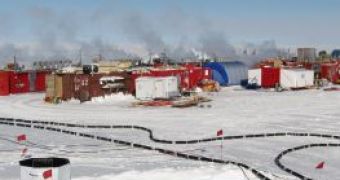The IceCube telescope at the South Pole is still under construction but it is already delivering valuable information. The latest news is something it was not even supposed to see: cosmic rays anisotropy. Once the scientists' amazement passed, they started working on better ways to understand this phenomenon and find out its possible causes.
The newly published study used data gathered in 2007 and 2008, from 22 strings of optical detectors in the telescope. Now, scientists will analyze data from the 59 of 79 strings that are operational and when the IceCube will be completed in 2011, they will process information from 86 strings and more that 5,000 digital optical sensors. After its complete construction, the telescope supported by the National Science Foundation will fill a cubic kilometer of Antarctic ice.
The initial purpose of the IceCube was to capture neutrinos that travel through the Earth, and that can provide important information about distant cosmic events like supernovas or black holes, in the part of space that can be seen from the Northern Hemisphere. But when Rasha Abbasi, researcher at the University of Wisconsin-Madison saw an unusual pattern when looking at a skymap of cosmic rays directed toward the Southern Hemisphere, she thought that this could be more than just background noise.
“IceCube was not built to look at cosmic rays. Cosmic rays are considered background,” Abbasi said. “However, we have billions of events of background downward cosmic rays that ended up being very exciting.”
The pattern that Abbasi saw was an overabundance of cosmic rays in one part of the sky and a deficiency in another. This phenomenon is called “anisotropy” and it has already been observed from the Northern Hemisphere by previous experiments. Abbasi along with researcher Paolo Desiati and collaborator Juan Carlos Díaz-Vélez saw an extraordinary opportunity of better studying cosmic ray data.
“At the beginning, we didn't know what to expect. To see this anisotropy extending to the Southern Hemisphere sky is an additional piece of the puzzle around this enigmatic effect - whether it's due to the magnetic field surrounding us or to the effect of a nearby supernova remnant, we don't know,” she said.
Right now “we can predict some models, but we don't have concrete knowledge of the magnetic field on small scales,” Abbasi says. “It would be really nice if we did - we would have made a lot more progress in the field.”
As for the exploded supernova theory, there is a possibility that the irregular pattern is caused by supernova remnant Vela, whose location is the same as one of the cosmic ray hotspots in the anisotropy skymap.
"This is exciting because this effect could be the 'smoking gun' for our long-sought understanding of the source of high-energy cosmic rays," added Abbasi, according to ScienceDaily.

 14 DAY TRIAL //
14 DAY TRIAL //